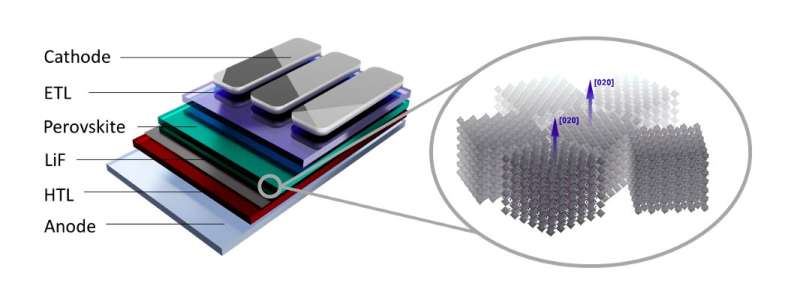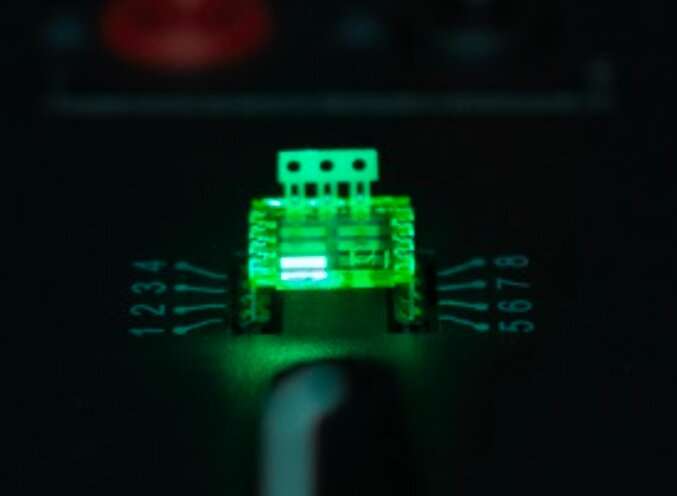November 20, 2020 feature
Efficient light-emitting diodes made by depositing perovskites on a fluoride interface

Light-emitting diodes (LEDs) are devices that emit light when electrical current flows through them, traditionally fabricated using semiconducting materials. Over the past few years, scientists and electronics engineers have been exploring the potential of LEDs made of perovskites, a class of materials often used to create photovoltaic (PV) technology with many possible compositions and numerous potential properties, such as superconductivity and magnetoresistance.
While some perovskite-based LEDs have recently achieved external quantum efficiencies over 20%, particularly those made of halide perovskites, their performance can be negatively affected by non-radiative recombination losses. In addition, perovskites can only be deposited on a limited range of charge-transport materials, which may limit their potential for fabricating LEDs with improved performance.
Researchers at University of Cambridge and Zhejiang University recently created highly efficient LEDs by depositing mixed-dimensional perovskites on a thin lithium fluoride interface. The fabrication strategy they used, outlined in the cover article of the latest issue of Nature Electronics, resulted in LEDs with remarkable external quantum efficiencies, while also enabling the deposition of perovskites on a material that they are typically incompatible with.
The researchers have been conducting research into perovskite-based LEDs for a few years now. Back in 2018, they created a near-infrared LED using perovskite-polymer heterostructures that achieved external quantum efficiencies of over 20% and internal quantum efficiencies of almost 100%.
As they were fabricating this LED, as well as other devices, the researchers encountered difficulties in merging perovskite layers with charge-transporting layers that are incompatible with perovskite deposition processes. For instance, they tried to use TFB, a hole-transporting polymeric semiconductor that they had previously used to create high-efficiency solution-processed OLEDs to build efficient green perovskite LEDs; however, they achieved poor results.
"We realized that it was not possible to form emissive perovskite layers on the TFB polymer due to the strong hydrophobicity of the polymer surface," Prof. Dawei Di at Zhejiang University, who jointly supervised the work with Prof. Richard Friend of the University of Cambridge, told TechXplore. "So the motivation of our new study was to reliably deposit mixed-dimensional perovskite light-emitting films on suitable charge-transport layers for high-performance LEDs. Fortunately, we found that by coating the TFB surface with a polar dielectric interface such as a nanometer-thin layer of lithium fluoride, it is possible to form highly luminescent perovskite layers for efficient LEDs."
To fabricate their mixed-dimensional perovskite-based LEDs, the researchers first prepared a perovskite precursor solution. They then proceeded with the spin-coating deposition of hole-transporting polymer TFB on an ITO-coated glass substrate. This was followed by a thermal annealing treatment and the thermal evaporation of a thin lithium fluoride layer on the TFB surface.

The perovskite precursor solution was deposited on the lithium fluoride coated TFB and a TPBi organic electron-transporting layer was created via thermal evaporation. Finally, the researchers thermally evaporated lithium fluoride/aluminum contacts through a shadow mask and encapsulated the LED.
"The main difference between this new design and those we created in the past is that we have now inserted a thin layer of lithium fluoride between the polymer hole-transport layer and the perovskite layer," Di said. "The fluoride layer holds the 'sandwich-like' multi-layer device structure together. Importantly, as we have found in our previous study, a key to high perovskite LED efficiency is the elimination of interfacial non-radiative energy losses. The fluoride interface serves this purpose very well."
The new LED design has many advantages. The most remarkable, however, is that it enables the combination of perovskites with a range of polymeric hole-transport layers that are typically incompatible with them, by introducing a highly polar lithium fluoride interface in between the two materials. This interface makes the polymeric surfaces hydrophobic, allowing the perovskites to form on top of it.
"We observed that the photoluminescence quantum efficiency of the perovskite films we prepared was related to the polarity of the chemical bonds in the interface they were deposited on," Baodan Zhao and Yaxiao Lian, co-first authors of the paper, told Tech Xplore via email.
The relation between the photoluminescence quantum efficiency of the perovskite films and the polarity of the chemical bonds in the interface unveiled by the researchers has important implications. In fact, it essentially means that the emission efficiency of the perovskite-based LED could be easily controlled by changing the chemical properties of the substrates they are placed on.
"We found that by using ultrathin fluoride interfacial layers, it is possible to form and integrate highly luminescent perovskite layers into LED device structures similar to high-efficiency solution-processed OLEDs," Di said. "Our device achieved a high external quantum efficiency of >19.1% at high brightness (>1500 cd/m2) relevant to display applications. Our findings expand the currently limited library of perovskite LED device architectures and may accelerate development in this area."
By enabling the deposition of perovskites on polymers that they are typically incompatible with, the new fabrication strategy opens up interesting possibilities for the development of perovskite-based devices. In their future work, the researchers will continue investigating the potential of the design strategy they identified, while also exploring alternative approaches for creating LEDs.
"We now plan to further improve the light emission efficiency of perovskite LEDs by using mechanisms such as photon recycling, a process that can reuse photons that are otherwise lost in the devices," Di said. "We will also work on blue perovskite LEDs and the issues related to operational stability."
More information: Baodan Zhao et al. Efficient light-emitting diodes from mixed-dimensional perovskites on a fluoride interface, Nature Electronics (2020). DOI: 10.1038/s41928-020-00487-4
Baodan Zhao et al. High-efficiency perovskite–polymer bulk heterostructure light-emitting diodes, Nature Photonics (2018). DOI: 10.1038/s41566-018-0283-4
Dawei Di et al. High-performance light-emitting diodes based on carbene-metal-amides, Science (2017). DOI: 10.1126/science.aah4345
© 2020 Science X Network


















